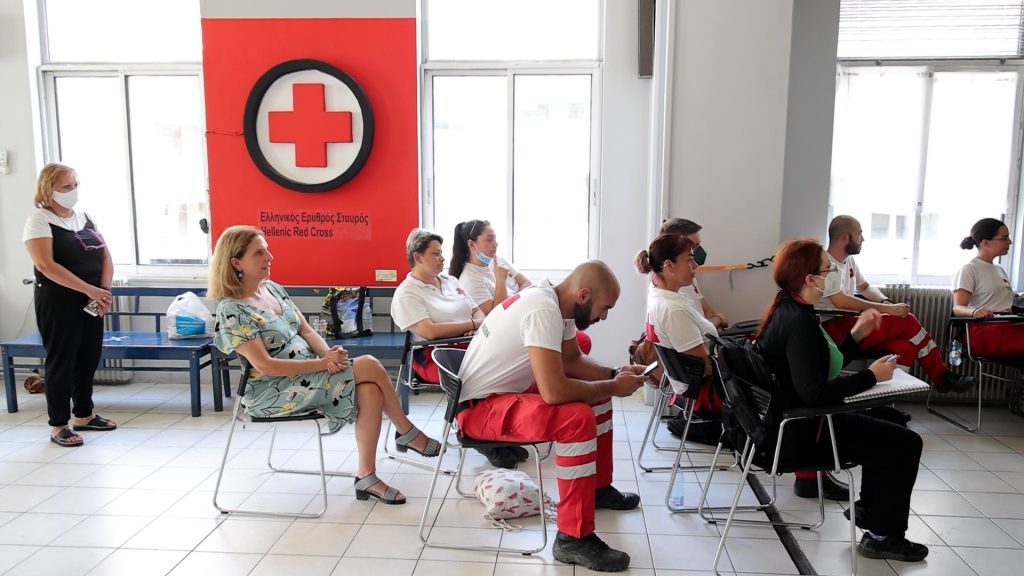Cooling the capital: How Athens is designing a cooler future
By Catherine Wallace Tue, Nov 21, 2023
Amid rising temperatures, Athens, Greece has taken bold steps to combat extreme heat. The city’s Chief Heat Officers have worked to raise awareness, increase preparedness, and redesign the city for a cooler, safer future.
Even before the summer of 2023—when Greece faced its longest and most intense recorded heat wave—Athens was considered one of the hottest capitals in Europe. Over the past decade, temperatures have swiftly risen, prompting increased measures to ensure the safety of the city’s residents and influx of tourists (the Acropolis alone receives an estimated 17,000 daily visitors).
Athens has recognized the dangers of extreme heat for years and was the first city in Europe to appoint a Chief Heat Officer. Eleni Myrivili was appointed to the role in 2021 and held the position until she became the Global Chief Heat Officer to UN Habitat and the Arsht Rock Resilience Center. Since May 2023, Elissavet Bargianni has been responsible for the city’s heat resilience solutions and policies. Both Chief Heat Officers have focused on three key pillars of work:
- Raising awareness,
- Increasing individual and community preparedness, and
- Promoting urban redesign to make the city cooler.
Raising awareness on the silent threat of extreme heat
While the earth has entered an era of “global boiling,” there is still a lack of awareness around the negative—and too often lethal—impacts of extreme heat on human health. As Myrivili said in an interview, “it’s total cognitive dissonance that this information is not common knowledge.” This is particularly true in historically hot places like Athens, where residents do not always recognize that the heat they are experiencing now is different and far deadlier than the heat of the past.
One of the steps Athens has taken to bridge the awareness gap is to categorize heat waves using an algorithm developed by Arsht-Rock. The system projects the impact of heat on human health by using both current meteorological variables and the algorithm linked to local, historical meteorological and mortality data. This health-based system enables six Greek municipalities, including Athens, to issue early warnings that are tailored to the severity of the heat wave. The country has also begun naming heat waves to better signal the coming danger and bring attention to dangerous heat—as it did with heat wave Cleon in July 2023—similar to how naming hurricanes or tornados reinforces the seriousness of the weather event.
By categorizing and naming heat waves, Athens is able to alert key actors like social services personnel, nursing home workers, refugee and migrant organizations, and first responders to a threatening heat event. The early warning gives them the time and awareness to take steps to protect vulnerable people.
The alerts are also a way to educate people in Athens on the ways they can protect themselves. Bargianni points out that, “the promotion of simple but effective practices like staying hydrated and seeking shade can quite easily be the difference between life and death.”
Empowering communities through preparedness and response
As the city raises awareness, its Chief Heat Officers are also empowering stakeholders and members of the community with the resources they need to protect themselves and others against extreme heat’s worst impacts. Through a partnership Myrivili helped create with the smart phone app Extrema Global, users in Athens are provided with personalized risk assessments on hot days and can identify free public spaces to escape the heat—including public buildings with air conditioning, train stations, and swimming pools. The app can also confirm the coolest route to take when traversing the city, keeping residents and tourists safer.

Myrivili and Bargianni have also worked to prepare government officials and community leaders for extreme temperatures. Through a partnership with the International and Hellenic Red Cross, the city offered a series of heat preparedness workshops for employees in the municipal Health Department. The partnership also focused on providing training and support for those working with residents over sixty, who are among the most vulnerable to heat. They offered seminars for municipal employees working in the city’s Friendship Clubs, where people over sixty are able to socialize and participate in activities. They also provided trainings for “Help at Home+” employees, who provide in-home care for residents with medical emergencies, the elderly who are not able to receive help from their family, and people that live alone. Through its partnership with the Red Cross, the city was also able to expand its “Help at Home+” program with the support of the NGO’s volunteers.
Both Myrivili and Bargianni have also worked to protect those who are outside during the hottest parts of the day—especially those experiencing homelessness, who they have identified as particularly vulnerable during heat waves. They have ensured there are cooling centers in each of the city’s seven districts to make cooling more inclusive and accessible, and have partnered with organizations like the Red Cross to provide water and advice on how to stay safe to everyone from its residents to tourists visiting the city’s most popular attractions.
Redesign for a cooler future
For Myrivili, summer in Athens used to be a time when “we all went outside and had these great big groups of people hanging out in public spaces…making the city alive and making it vibrant.” She feared that the extreme temperatures could force the city’s residents to rely on air conditioning, despite the fact that many households do not have access to it or cannot afford to regularly use it. With this in mind, Myrvili and Bargianni are working to redesign the city and bring cooling outside.
Redesign is not only about adopting the latest technology, but also taking inspiration from the past to drive change in the future. Myrivili has spearheaded efforts to use water from a nearly 2,000-year-old aqueduct to expand the city’s green footprint and shade cover. Moreover, she has advocated for drawing on centuries of wisdom about how to design buildings that are fine-tuned to the local climate and coupling these designs with innovative materials and solutions for this new climate era. For Athens, this means adopting practices that can be as simple as whitewashing walls to reflect the summer heat or adding outside shutters that keep the building’s interior cooler.
Both Myrivili and Bargianni have also focused much of their work on urban greening, an important method for reducing the urban heat island effect. They are planting pocket parks in city streets and intersections to decrease the air temperature while also increasing biodiversity. Additionally, they have established a set of guidelines on how to design cooler public spaces such as parks, streets, and squares, using plants, water and building materials that cool rather than trap heat.

As Athens confronts the escalating challenges of extreme heat, the collaboration between the city’s Chief Heat Officer, the local government, and key stakeholders stands as a promising model for fostering a more resilient city. Through their efforts, Athens has paved the way for other cities to address the urgent need for heat-related strategies in an era of escalating climate change.
Catherine Wallace is the associate director of strategic partnerships and advocacy for the Arsht-Rock Resilience Center.